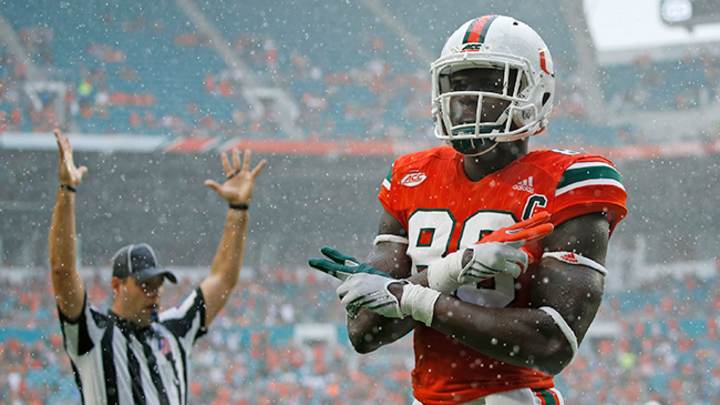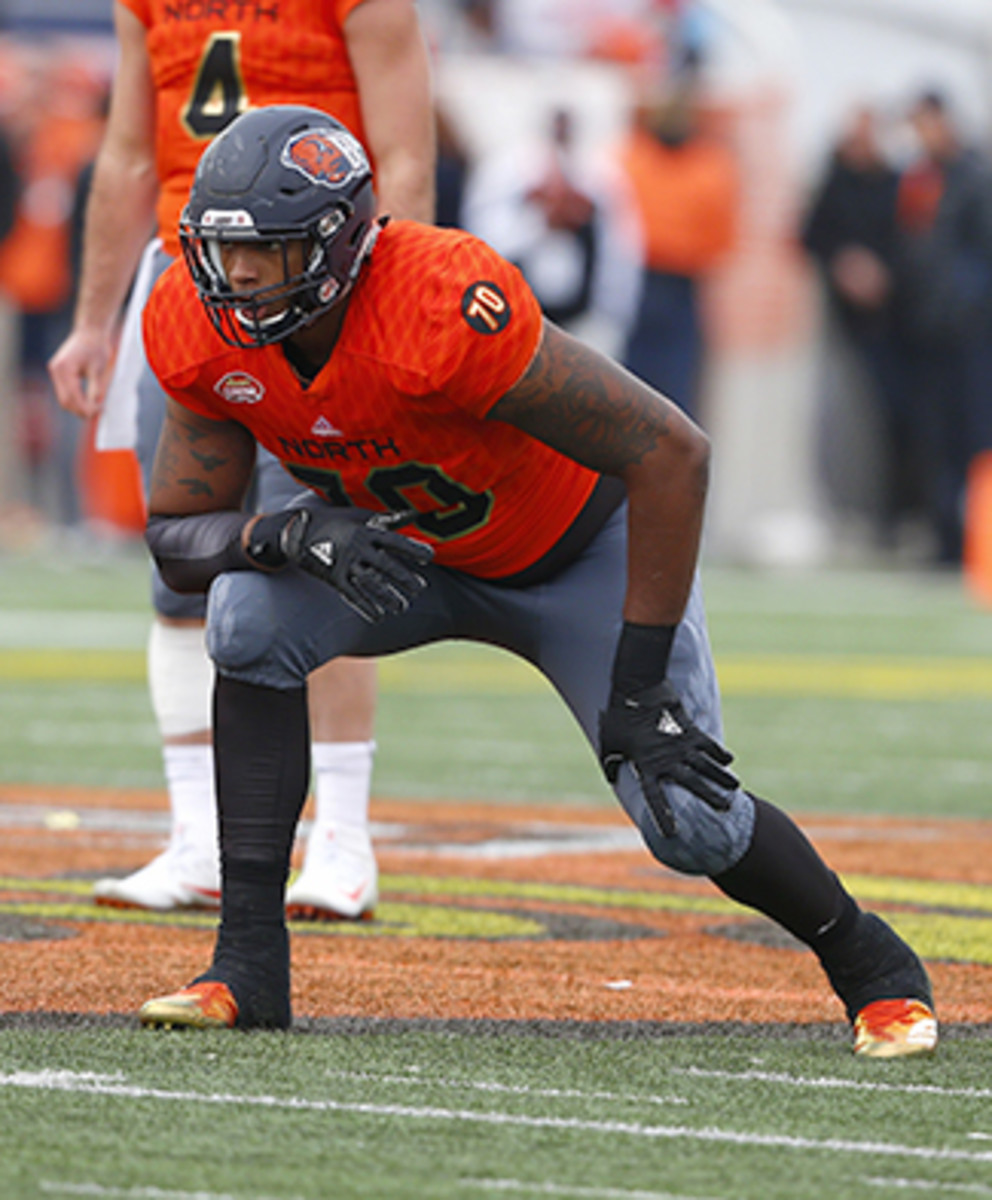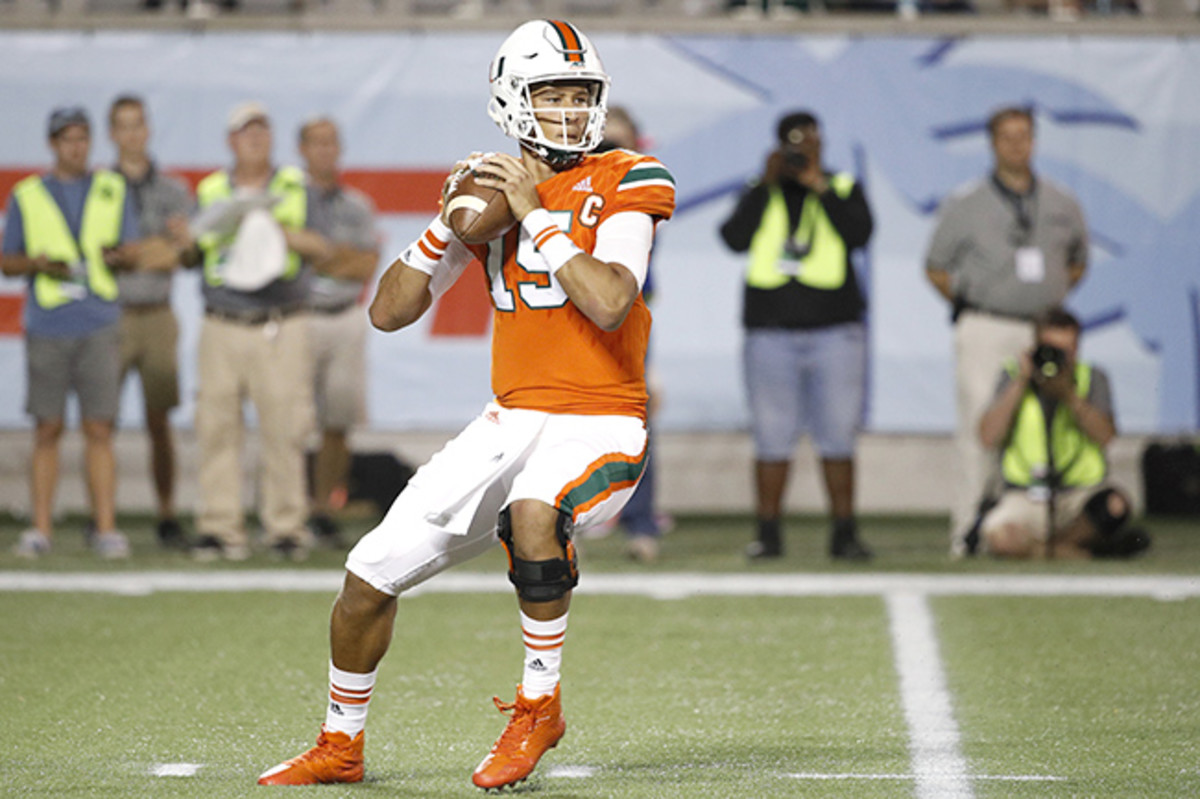David Njoku Could Own the Combine

When Mark Richt was hired at Miami 15 months ago, his coaching staff took stock of the roster. One player, specifically, stood out as exciting and promising, but also perplexing. David Njoku is the son of Nigerian immigrants and product of a small New Jersey high school. He was a national champion high jumper (personal best: 7'1"). A high school wide receiver, Njoku packed nearly 30 pounds onto his 6'4" frame during his redshirt year in 2014, so coaches gave him a No. 50 jersey and tried him at outside linebacker. And then it was decided he should be a tight end. He had 21 catches as a redshirt freshman, before Richt and his staff arrived.
“One of the first drills in spring ball, he catches a ball in the flat, turned and just took off down the sideline, and I said, ‘I think we have something special,’ ” says Miami’s tight end coach Todd Hartley. “The natural bend and flexibility and athleticism and twitch—he has it all.”
Bend, flexibility, athleticism and twitch—welcome to combine week. As the festivities kick off in Indianapolis, get ready to incorporate these words into your vocabulary (along with: ceiling, football IQ, motor, road grader, second gear and upside). The combine is the marquee event of draft season, and in Indy, stock is contingent on measurables. It’s important to remember that a player’s draft stock is still fluid (fluid, by the way, is another favored scouting term, especially pertaining to hip movement.) Tom Brady famously labored through a 5.28-second 40-yard dash in 2000. One year later, Drew Brees’ height concerned scouts, as did his accuracy during the combine throwing session. NaVorro Bowman, Vontaze Burfict and Terrell Suggs were all considered to have had mediocre combine performances.
In this column, I’ll prime you for the combine based on conversations with evaluators throughout the season. We’ll go over which numbers matter, which ones don’t, and which small-school gems you need to know. We figure to once again leave Indianapolis gushing about the feats of the “athletic freaks.” And in 2017, there is perhaps no bigger freak than Njoku.
* * *

As Hartley saw during that spring practice, Njoku’s best attribute is run-after-catch ability. He’s expected to run 4.6 or better, and scouts say he should measure at 6'4½" and around 245 pounds. Last season he caught 43 passes for 698 yards and eight touchdowns—that’s right, 16.2 yards per reception, and a touchdown on one of every five catches. NFL evaluators believe he’s a tight end/h-back who can play in-line, in the slot or out wide. As for blocking, “he certainly wasn’t the best, but he was willing, and that’s all you need,” Hartley says. “We go up against big defensive ends from Florida State and Virginia Tech, and you need to be able to block those dudes. He’s tough enough to throw your face mask on somebody. When he gets his hands on you, he can just turn you and torque you and move you because of his strength.”
Consider, Njoku has only been playing tight end for two years. He is one of the youngest players in this year’s draft (he turns 21 in July).
Says Mike Mayock: “I think people are salivating about him, because they really don’t know him well but are fascinated at the kind of prospect he might be. He might be a little bit of a project, but so athletically gifted. Depending where you put him on the field, I think he wins a lot of matchups as a rookie.”
Despite the high demand, a tight end hasn’t been taken in the first round of the draft since 2014. This year is an exceptionally deep class. That could mean teams are willing to wait until the mid-rounds when they can pick up say, Michigan’s Jake Butt, who is recovering from an ACL injury. But if Njoku shows off like he’s expected to in Indianapolis, don’t be surprised if he joins Alabama’s O.J. Howard in Round 1.
* * *

One of the players I was most excited to see at the Senior Bowl was Bucknell offensive lineman Julie’n Davenport. Or was it Julién? I had seen it spelled both ways. According to a scout, Bucknell printed his name incorrectly in the media guide as a freshman, Davenport was too shy to correct them and lived for four years with everyone spelling it wrong.
“That’s true,” says Julién (correct spelling), when I relayed the story to him last week. “I didn’t want to make it a big deal, I let it roll. Now that I’m going through this whole process I’m like, Alright, time to get this thing fixed.”
It’s a good time to press reset for Davenport, who no longer is big man on campus. He’s still quite large—at the Senior Bowl he measured 6'6" (and 3/4), 310 pounds, with 36-inch arms and an 87-inch wingspan, longest of any player—but must prove he can dominate outside the Patriot League. Davenport is looking to be the first Bucknell player drafted since 1969 (Sam Havrilak, a eighth-round pick of the Baltimore Colts, in case you were wondering).
Davenport is flexible and has agile feet for his size—he played basketball in high school—and scouts began noticing him as a freshman. He played left tackle at Bucknell, and though the Bears coaching staff gave him a few snaps at right tackle during Senior Bowl practice, most evaluators project him on the left side. Says one evaluator who watched him in Mobile: “He’s a developmental pick with true left tackle upside. Lacks core strength, but love the body, length and wingspan.”
* * *
By now you’ve likely heard about Eastern Washington’s Cooper Kupp and East Carolina’s Zay Jones as small-school receivers with big-time potential. Here’s another to add to your list: Taywan Taylor of Western Kentucky. A polished route-runner, Taylor was one of the most productive receivers in college football and played up to his competition. When the Hilltoppers faced LSU in 2015, Taylor had 10 catches for 103 yards plus a touchdown. And in 2016 against Alabama: 121 yards on nine catches.
One other small-school player to look out for is Taylor’s Western Kentucky teammate Forrest Lamp. There’s some first-round buzz surrounding Lamp, a left tackle in college who will likely slide inside to guard. Like Taylor, Lamp shined against top competition. A scout I talked to raved about his tape against Alabama. “Best front seven in the country, and this guy goes up against Jonathan Allen and Tim Williams and wins battles,” the scout says. “Forrest Lamp is a Day 1 starter.”
* * *
QUICK HITS

Taking over for our usual Five Things You Need to Know department, here’s a roundup of what I’ll be watching for in Indianapolis…
• Is there anything Texas A&M defensive end Myles Garrett could do that would prevent him from being the No. 1 overall pick? I posed this question to a scout over the weekend, and he responded: “It would take something surprising. Let’s just say teams have been studying him for a while. You know what you’re going to get.”
• What’s going on with Brad Kaaya? Entering the 2016 season, the big storyline was: Kaaya or Deshaun Watson, who goes No. 1? Watson has stayed afloat, but Kaaya, who declared for the draft after his junior year, seems to be slipping. He’s now being discussed as a developmental quarterback. What’s interesting is that Kaaya is considered the most prototypical pocket passer of the 2017 class. I asked two scouts about him, and reactions were mixed. One scout pointed to his uneven tape; there is concern he crumbles when his pocket breaks down, and he’s not very mobile. “He’s not going to wow you with his arm strength,” the scout said, noting Kaaya would be best matched with a West Coast offense. Said the other scout: “I think there was just a little too much hype on him early. He still has a chance to be very good. He’s a great kid, and everything you hear about him off the field is positive, but he’s going to need some work.”
• Here’s an area where size probably doesn’t matter. UNC’s Mitch Trubisky currently leads the quarterback pack. There was a bit of kerfuffle last week, however, on how Trubisky would measure at the combine. He’s listed on the Tar Heels’ roster at 6'3", though most scouts believed he was 6'2" at best. Mayock suggested Trubisky might only be 6'1"; that made UNC coach Larry Fedora very defensive in an interview with Cleveland.com. Does all of this sound silly to you? Same here. Bottom line is, Trubisky is likely taller than 6'1", which is tall enough, so it shouldn’t affect his stock.
• Here’s an area where size does matter. San Diego State’s DonnelPumphrey surpassed Ron Dayne as the NCAA’s all-time leading rusher. He averaged 6.1 yards per carry last season, has great vision, is patient hitting holes and has good body control. But a few NFL teams harbor serious concerns about drafting a player who (per Senior Bowl measurements) is 5'8", 169 pounds. Darren Sproles is the default example for undersized backs, but Sproles has 20 pounds on Pumphrey. Dexter McCluster (5'8", 170) might be a better comparison. The belief is that Pumphrey, too, could excel in the right offense, one that incorporates him in the pass game (an area in which he needs polish). Another knock against Pumphrey: He has virtually no experience as a return specialist (five kickoff returns, zero punt returns over four collegiate seasons). Expect Pumphrey to weigh in a few pounds heavier at the combine, but I get the feeling his size will make him a Day 3 pick.
• In my profile of John Ross, I called him the fastest wide receiver of the 2017 draft. I immediately got a few tweets and emails from readers, furious that I snubbed Florida State’s Kermit Whitfield. Even if you’re not a die-hard college football fan, you probably remember Whitfield, who scored on a 100-yard kick return in the 2014 title game against Auburn. Indeed, Whitfield—a high school track star—is blazing fast. He could be faster than Ross, and don’t be surprised if either player breaks 4.30 in the 40-yard dash. So yes, my apologies to Whitfield. But while Ross is a projected first-rounder, the 5' 8" Whitfield is likely a Day 3 pick.
• Speaking of Ross, teams are very interested in scanning his medical reports. He’s likely having shoulder surgery after the combine, but he has also had significant injuries to both knees earlier in his career. Even though Ross played his best football this past season—showing no effects after a torn ACL—teams will want a closer look. Other high-profile players whose medicals will be under scrutiny: Michigan tight end Jake Butt, Florida State running back Dalvin Cook, Ohio State safety Malik Hooker, Alabama linebacker Reuben Foster and Wisconsin offensive tackle Ryan Ramczyk.
• Ross, Western Michigan’s Corey Davis and Clemson’s Mike Williams are the top wide receivers. In what order? Depends on who you ask, though Williams might have the slight edge now. There is a chance one of the receivers could separate from the pack at the combine; remember, though—Davis recently underwent minor ankle surgery and won’t be running the 40. I have never met Williams, so don’t read into his omission here, but I have spent time with both Davis and Ross and I will say this: Both are film junkies, both have excellent work ethics, and both are very impressive off the field. I think Davis and Ross will make some teams swoon in interviews.
• Feel Good Story of the 2017 Draft No. 1: Pittsburgh running back James Conner, who missed most of the 2015 season while battling Hodgkin’s lymphoma, received a clear scan last week. Here’s colleague Brian Hamilton’s profile of Conner from the fall.
• Feel Good Story of the 2017 Draft No. 2: Penn State defensive end Garrett Sickles will use his bench press performance at the combine to raise money for rare disease research. As of Monday night, he was almost at his goal of $5,000 (he aimed for $250 per 225-pound rep, and he estimated he would hit 20).
• Feel Good Story of the 2017 Draft No. 3: South Florida wide receiver Rodney Adams hopes to raise $3,000 with his performance in the vertical leap. Adams’ cause is Experience Camps, which provides getaways for children who recently lost caregivers or family members. Adams’ mother was killed in a car accident in 2013.
Question or comment? Email us at talkback@themmqb.com.
